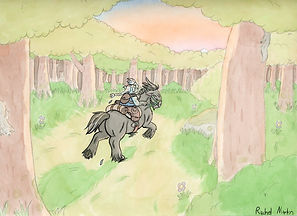
Rachel Martin's Original Species
Dullabeasts
© 2020 Rachel Martin (Cartoon Creature Lover) | All rights reserved.
Dullabeasts are relatives to the more human-like Dullatroll, being closer related to trolls. Despite their feral looks, they are just as intelligent as Dullatrolls, & some have even travelled to Dullatroll towns to live & work amongst their relatives! These creatures typically travel in groups from playing children to hunting adults!
Most Dullabeasts only know Nestian, the native language of Troll’s Nest, where they are from! Most may not know what books are, but many know the dangers of nature & how to deal with them. Despite how “behind the times” most Dullabeasts can seem to some, they do in fact wear clothes, have traditions, culture, keep good records of events, entertainment, use magic, & more!
Biology
1
1
1
1
1
1
Culture
1
Dullabeast dens are usually caves/large underground “living holes” that either they’ve dug themselves, or are caves/holes under rocks & trees they found. These creatures are typically nomadic & travel all across the land & usually travel across the same areas for their entire lives.
Dullabeast bedding is fairly minimalist since they’re nomads. They have large blankets made from animal pelts that they lay on. Between 6-20 Dullabeasts tend to sleep together in a den at a time. They’ll lay on the fur blanket & on each other. Babies will usually in the deepest part of the den surrounded by older Dullabeasts to maximize warmth & safety. Usually the strongest & scariest Dullabeasts sleep closest to the entrance in case any creature dares to attack them.
Dullabeasts do not traditionally eat with any type of silverware, as they were not introduced to eating with tools for thousands of years. Dullabeasts today do not eat with silverware, as they are seen as a waste of materials & because all of their dishes have been designed to be eaten with their fingers &/or without the need of silverware at all!
Dullabeasts usually wear the tanned hides & furs of their meals, as well as some fabric items made & traded with Dullatrolls. The hides are usually made into soft underwear & tough leather skirts. The fabric items from Dullatrolls are often colorful accessories such as limb wraps & scarves. Many hunter & scavenger Dullabeasts will wear leather belts around their torsos to hold weapons, trinkets, tools, or snacks.
For accessorizing, they'll wear beaded jewelry (both bone, wood, & stone beads they made themselves, as well as glass beads from Dullatrolls) such as chokers, bracelets, & anklets. Sometimes, they find beads or jewelry left behind from adventurers or travelers that they then take & use for themselves.
Unlike their relatives, Dullabeasts tend to keep their manes short. Even though their heads do detach, they don’t worry as much if something happens to their heads because takes a force greater or equal to the weight of their heads to actually knock their heads off of their bodies. Dullabeast heads tend to weigh roughly 100 lbs, & not very many creatures are capable of knocking their heads off besides large-sized trolls & themselves. They tend to keep their manes short because it’s easier to take care of & so their heads don’t get caught on things if their hair is tangled. Some keep their manes long anyways, but usually keep them in braids or dreadlocks in order to keep their manes from getting “too wild.”
Features & Design Rules
Some Examples Of Dullabeasts






